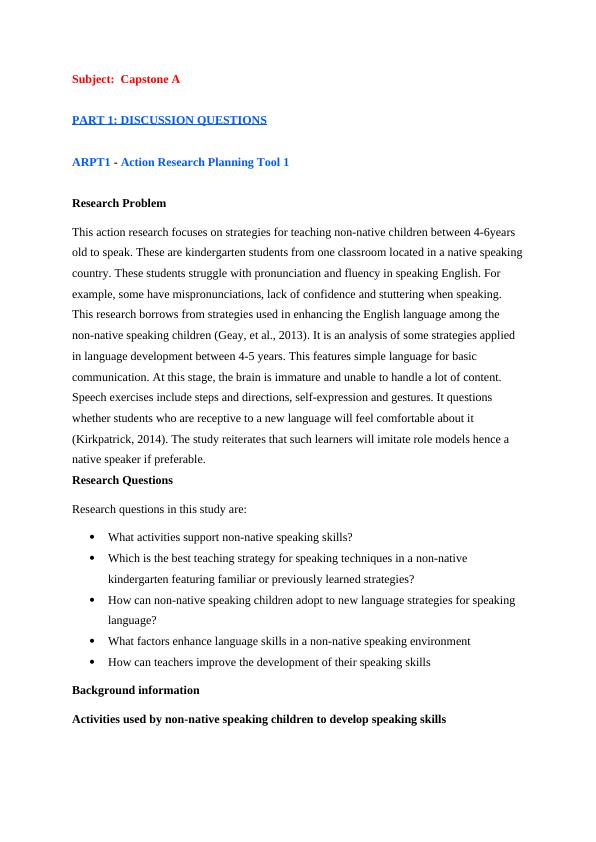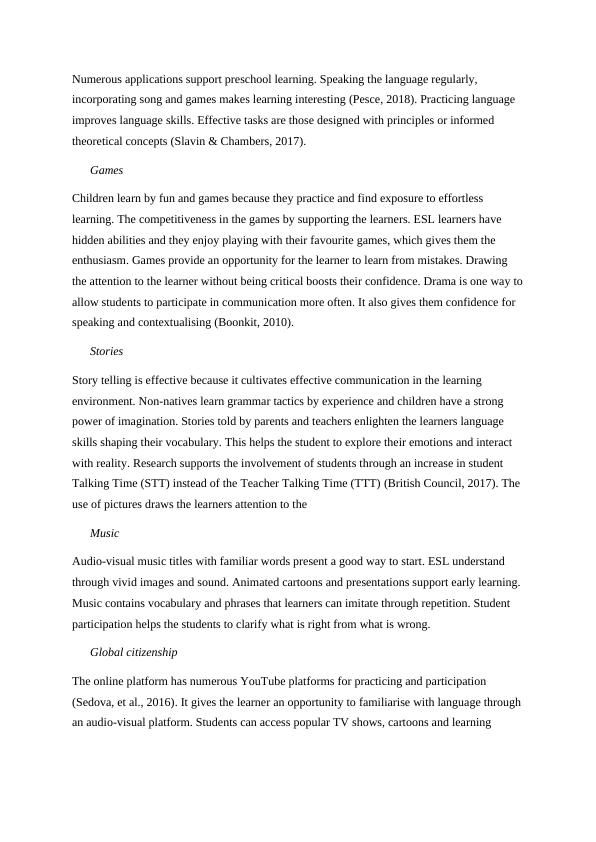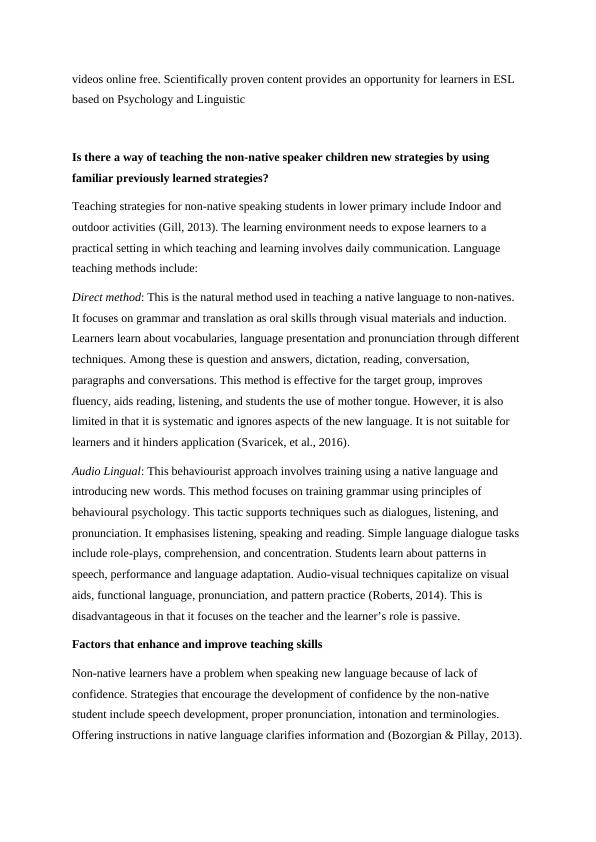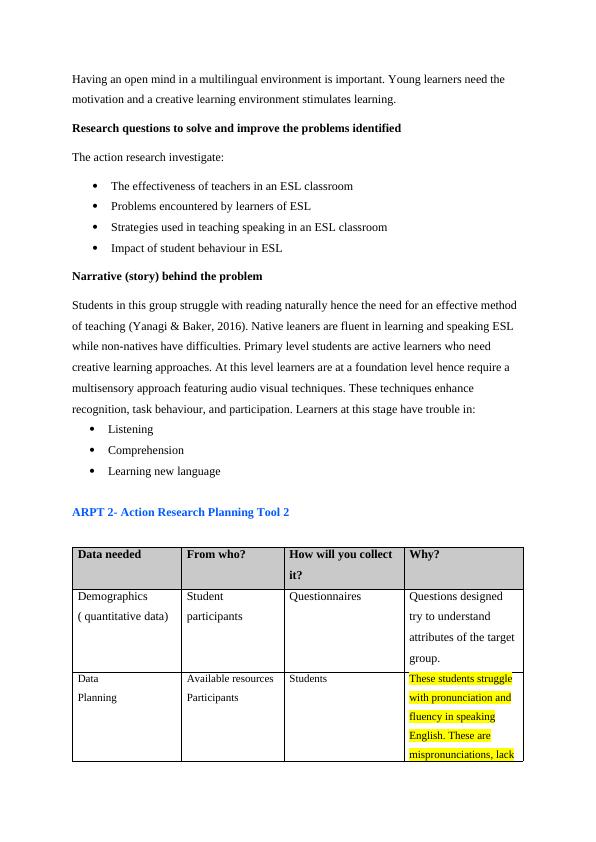Strategies for Teaching Non-Native Children to Speak English: An Action Research
The assignment is a literature review on ways to enhance the non-native speakers of English in the classroom.
29 Pages6912 Words225 Views
Added on 2023-06-12
About This Document
This action research focuses on strategies for teaching non-native children between 4-6 years old to speak English. It analyzes the effectiveness of different teaching strategies and factors that enhance language skills in a non-native speaking environment. The research questions include identifying activities that support non-native speaking skills, the best teaching strategy for speaking techniques, and how non-native speaking children can adopt new language strategies. The study also explores factors that enhance language skills and how teachers can improve their speaking skills. The subject is Capstone A.
Strategies for Teaching Non-Native Children to Speak English: An Action Research
The assignment is a literature review on ways to enhance the non-native speakers of English in the classroom.
Added on 2023-06-12
ShareRelated Documents
Subject: Capstone A
PART 1: DISCUSSION QUESTIONS
ARPT1 - Action Research Planning Tool 1
Research Problem
This action research focuses on strategies for teaching non-native children between 4-6years
old to speak. These are kindergarten students from one classroom located in a native speaking
country. These students struggle with pronunciation and fluency in speaking English. For
example, some have mispronunciations, lack of confidence and stuttering when speaking.
This research borrows from strategies used in enhancing the English language among the
non-native speaking children (Geay, et al., 2013). It is an analysis of some strategies applied
in language development between 4-5 years. This features simple language for basic
communication. At this stage, the brain is immature and unable to handle a lot of content.
Speech exercises include steps and directions, self-expression and gestures. It questions
whether students who are receptive to a new language will feel comfortable about it
(Kirkpatrick, 2014). The study reiterates that such learners will imitate role models hence a
native speaker if preferable.
Research Questions
Research questions in this study are:
What activities support non-native speaking skills?
Which is the best teaching strategy for speaking techniques in a non-native
kindergarten featuring familiar or previously learned strategies?
How can non-native speaking children adopt to new language strategies for speaking
language?
What factors enhance language skills in a non-native speaking environment
How can teachers improve the development of their speaking skills
Background information
Activities used by non-native speaking children to develop speaking skills
PART 1: DISCUSSION QUESTIONS
ARPT1 - Action Research Planning Tool 1
Research Problem
This action research focuses on strategies for teaching non-native children between 4-6years
old to speak. These are kindergarten students from one classroom located in a native speaking
country. These students struggle with pronunciation and fluency in speaking English. For
example, some have mispronunciations, lack of confidence and stuttering when speaking.
This research borrows from strategies used in enhancing the English language among the
non-native speaking children (Geay, et al., 2013). It is an analysis of some strategies applied
in language development between 4-5 years. This features simple language for basic
communication. At this stage, the brain is immature and unable to handle a lot of content.
Speech exercises include steps and directions, self-expression and gestures. It questions
whether students who are receptive to a new language will feel comfortable about it
(Kirkpatrick, 2014). The study reiterates that such learners will imitate role models hence a
native speaker if preferable.
Research Questions
Research questions in this study are:
What activities support non-native speaking skills?
Which is the best teaching strategy for speaking techniques in a non-native
kindergarten featuring familiar or previously learned strategies?
How can non-native speaking children adopt to new language strategies for speaking
language?
What factors enhance language skills in a non-native speaking environment
How can teachers improve the development of their speaking skills
Background information
Activities used by non-native speaking children to develop speaking skills

Numerous applications support preschool learning. Speaking the language regularly,
incorporating song and games makes learning interesting (Pesce, 2018). Practicing language
improves language skills. Effective tasks are those designed with principles or informed
theoretical concepts (Slavin & Chambers, 2017).
Games
Children learn by fun and games because they practice and find exposure to effortless
learning. The competitiveness in the games by supporting the learners. ESL learners have
hidden abilities and they enjoy playing with their favourite games, which gives them the
enthusiasm. Games provide an opportunity for the learner to learn from mistakes. Drawing
the attention to the learner without being critical boosts their confidence. Drama is one way to
allow students to participate in communication more often. It also gives them confidence for
speaking and contextualising (Boonkit, 2010).
Stories
Story telling is effective because it cultivates effective communication in the learning
environment. Non-natives learn grammar tactics by experience and children have a strong
power of imagination. Stories told by parents and teachers enlighten the learners language
skills shaping their vocabulary. This helps the student to explore their emotions and interact
with reality. Research supports the involvement of students through an increase in student
Talking Time (STT) instead of the Teacher Talking Time (TTT) (British Council, 2017). The
use of pictures draws the learners attention to the
Music
Audio-visual music titles with familiar words present a good way to start. ESL understand
through vivid images and sound. Animated cartoons and presentations support early learning.
Music contains vocabulary and phrases that learners can imitate through repetition. Student
participation helps the students to clarify what is right from what is wrong.
Global citizenship
The online platform has numerous YouTube platforms for practicing and participation
(Sedova, et al., 2016). It gives the learner an opportunity to familiarise with language through
an audio-visual platform. Students can access popular TV shows, cartoons and learning
incorporating song and games makes learning interesting (Pesce, 2018). Practicing language
improves language skills. Effective tasks are those designed with principles or informed
theoretical concepts (Slavin & Chambers, 2017).
Games
Children learn by fun and games because they practice and find exposure to effortless
learning. The competitiveness in the games by supporting the learners. ESL learners have
hidden abilities and they enjoy playing with their favourite games, which gives them the
enthusiasm. Games provide an opportunity for the learner to learn from mistakes. Drawing
the attention to the learner without being critical boosts their confidence. Drama is one way to
allow students to participate in communication more often. It also gives them confidence for
speaking and contextualising (Boonkit, 2010).
Stories
Story telling is effective because it cultivates effective communication in the learning
environment. Non-natives learn grammar tactics by experience and children have a strong
power of imagination. Stories told by parents and teachers enlighten the learners language
skills shaping their vocabulary. This helps the student to explore their emotions and interact
with reality. Research supports the involvement of students through an increase in student
Talking Time (STT) instead of the Teacher Talking Time (TTT) (British Council, 2017). The
use of pictures draws the learners attention to the
Music
Audio-visual music titles with familiar words present a good way to start. ESL understand
through vivid images and sound. Animated cartoons and presentations support early learning.
Music contains vocabulary and phrases that learners can imitate through repetition. Student
participation helps the students to clarify what is right from what is wrong.
Global citizenship
The online platform has numerous YouTube platforms for practicing and participation
(Sedova, et al., 2016). It gives the learner an opportunity to familiarise with language through
an audio-visual platform. Students can access popular TV shows, cartoons and learning

videos online free. Scientifically proven content provides an opportunity for learners in ESL
based on Psychology and Linguistic
Is there a way of teaching the non-native speaker children new strategies by using
familiar previously learned strategies?
Teaching strategies for non-native speaking students in lower primary include Indoor and
outdoor activities (Gill, 2013). The learning environment needs to expose learners to a
practical setting in which teaching and learning involves daily communication. Language
teaching methods include:
Direct method: This is the natural method used in teaching a native language to non-natives.
It focuses on grammar and translation as oral skills through visual materials and induction.
Learners learn about vocabularies, language presentation and pronunciation through different
techniques. Among these is question and answers, dictation, reading, conversation,
paragraphs and conversations. This method is effective for the target group, improves
fluency, aids reading, listening, and students the use of mother tongue. However, it is also
limited in that it is systematic and ignores aspects of the new language. It is not suitable for
learners and it hinders application (Svaricek, et al., 2016).
Audio Lingual: This behaviourist approach involves training using a native language and
introducing new words. This method focuses on training grammar using principles of
behavioural psychology. This tactic supports techniques such as dialogues, listening, and
pronunciation. It emphasises listening, speaking and reading. Simple language dialogue tasks
include role-plays, comprehension, and concentration. Students learn about patterns in
speech, performance and language adaptation. Audio-visual techniques capitalize on visual
aids, functional language, pronunciation, and pattern practice (Roberts, 2014). This is
disadvantageous in that it focuses on the teacher and the learner’s role is passive.
Factors that enhance and improve teaching skills
Non-native learners have a problem when speaking new language because of lack of
confidence. Strategies that encourage the development of confidence by the non-native
student include speech development, proper pronunciation, intonation and terminologies.
Offering instructions in native language clarifies information and (Bozorgian & Pillay, 2013).
based on Psychology and Linguistic
Is there a way of teaching the non-native speaker children new strategies by using
familiar previously learned strategies?
Teaching strategies for non-native speaking students in lower primary include Indoor and
outdoor activities (Gill, 2013). The learning environment needs to expose learners to a
practical setting in which teaching and learning involves daily communication. Language
teaching methods include:
Direct method: This is the natural method used in teaching a native language to non-natives.
It focuses on grammar and translation as oral skills through visual materials and induction.
Learners learn about vocabularies, language presentation and pronunciation through different
techniques. Among these is question and answers, dictation, reading, conversation,
paragraphs and conversations. This method is effective for the target group, improves
fluency, aids reading, listening, and students the use of mother tongue. However, it is also
limited in that it is systematic and ignores aspects of the new language. It is not suitable for
learners and it hinders application (Svaricek, et al., 2016).
Audio Lingual: This behaviourist approach involves training using a native language and
introducing new words. This method focuses on training grammar using principles of
behavioural psychology. This tactic supports techniques such as dialogues, listening, and
pronunciation. It emphasises listening, speaking and reading. Simple language dialogue tasks
include role-plays, comprehension, and concentration. Students learn about patterns in
speech, performance and language adaptation. Audio-visual techniques capitalize on visual
aids, functional language, pronunciation, and pattern practice (Roberts, 2014). This is
disadvantageous in that it focuses on the teacher and the learner’s role is passive.
Factors that enhance and improve teaching skills
Non-native learners have a problem when speaking new language because of lack of
confidence. Strategies that encourage the development of confidence by the non-native
student include speech development, proper pronunciation, intonation and terminologies.
Offering instructions in native language clarifies information and (Bozorgian & Pillay, 2013).

Having an open mind in a multilingual environment is important. Young learners need the
motivation and a creative learning environment stimulates learning.
Research questions to solve and improve the problems identified
The action research investigate:
The effectiveness of teachers in an ESL classroom
Problems encountered by learners of ESL
Strategies used in teaching speaking in an ESL classroom
Impact of student behaviour in ESL
Narrative (story) behind the problem
Students in this group struggle with reading naturally hence the need for an effective method
of teaching (Yanagi & Baker, 2016). Native leaners are fluent in learning and speaking ESL
while non-natives have difficulties. Primary level students are active learners who need
creative learning approaches. At this level learners are at a foundation level hence require a
multisensory approach featuring audio visual techniques. These techniques enhance
recognition, task behaviour, and participation. Learners at this stage have trouble in:
Listening
Comprehension
Learning new language
ARPT 2- Action Research Planning Tool 2
Data needed From who? How will you collect
it?
Why?
Demographics
( quantitative data)
Student
participants
Questionnaires Questions designed
try to understand
attributes of the target
group.
Data
Planning
Available resources
Participants
Students These students struggle
with pronunciation and
fluency in speaking
English. These are
mispronunciations, lack
motivation and a creative learning environment stimulates learning.
Research questions to solve and improve the problems identified
The action research investigate:
The effectiveness of teachers in an ESL classroom
Problems encountered by learners of ESL
Strategies used in teaching speaking in an ESL classroom
Impact of student behaviour in ESL
Narrative (story) behind the problem
Students in this group struggle with reading naturally hence the need for an effective method
of teaching (Yanagi & Baker, 2016). Native leaners are fluent in learning and speaking ESL
while non-natives have difficulties. Primary level students are active learners who need
creative learning approaches. At this level learners are at a foundation level hence require a
multisensory approach featuring audio visual techniques. These techniques enhance
recognition, task behaviour, and participation. Learners at this stage have trouble in:
Listening
Comprehension
Learning new language
ARPT 2- Action Research Planning Tool 2
Data needed From who? How will you collect
it?
Why?
Demographics
( quantitative data)
Student
participants
Questionnaires Questions designed
try to understand
attributes of the target
group.
Data
Planning
Available resources
Participants
Students These students struggle
with pronunciation and
fluency in speaking
English. These are
mispronunciations, lack

of confidence and
stuttering. The research
uses strategies for
enhancing English
language among the
non-natives.
Student perception (
qualitative data)
Student participant Interviews The interview process
collects information
about student
perception of the
language environment
setting in order to
devise appropriate
social action required
Secondary data Researchers
( Literature
Literature review This is an analysis of
the background
information from
secondary sources of
research
Observational data (
Notes)
Classroom
environment
Observation/Note
taking
This is a process of
discovering strategies
used in learning by
viewing and making
conclusive remarks
ARPT 3- Action Research Planning Tool 3
Data Inferences on the problem/issue you identified
stuttering. The research
uses strategies for
enhancing English
language among the
non-natives.
Student perception (
qualitative data)
Student participant Interviews The interview process
collects information
about student
perception of the
language environment
setting in order to
devise appropriate
social action required
Secondary data Researchers
( Literature
Literature review This is an analysis of
the background
information from
secondary sources of
research
Observational data (
Notes)
Classroom
environment
Observation/Note
taking
This is a process of
discovering strategies
used in learning by
viewing and making
conclusive remarks
ARPT 3- Action Research Planning Tool 3
Data Inferences on the problem/issue you identified

The demographic data reveals information about the target group showing the ability of both
male and female students to speak a new language. This is a group of 20 learners aged 4-6 in
beginners class.
Structured Interviews collect data from face to face conversations with interviewees. The
questionnaires contain data on student perception on learning processes, strategies and
learning environment. It provides a highlight of activities that student enjoy doing and the
learning process ( See Appendix).
Observational data presents information about the learning environment. External factors
influence the leaners motivation. This includes the interior and external factors, sounds,
activities, colour and group.
The literature review analysis captures researched information from social science and
education. This data from qualified academic and professional data featuring learning
theories and concepts. It looks at studies done on competencies required for learners at the
age of 4-6 years, classroom interactions, motivation and models of learning ESL.
Objectives and study aim
The aim of this research is to:
Identify problems experienced by non-natives in learning to speak a new language
Determine factors influencing Non-native learners adoption of a second language at a
lower primary level
Highlight the role of strategic teaching practices in shaping non-native learners
Suggest solutions to challenges experienced by non-natives in speaking a new
language
ARPT 4- Action Research Planning Tool 4
1. Research problem
This action research focuses on strategies used in teaching non-native children between 4-
6years old to speak English.
2. Research goal
male and female students to speak a new language. This is a group of 20 learners aged 4-6 in
beginners class.
Structured Interviews collect data from face to face conversations with interviewees. The
questionnaires contain data on student perception on learning processes, strategies and
learning environment. It provides a highlight of activities that student enjoy doing and the
learning process ( See Appendix).
Observational data presents information about the learning environment. External factors
influence the leaners motivation. This includes the interior and external factors, sounds,
activities, colour and group.
The literature review analysis captures researched information from social science and
education. This data from qualified academic and professional data featuring learning
theories and concepts. It looks at studies done on competencies required for learners at the
age of 4-6 years, classroom interactions, motivation and models of learning ESL.
Objectives and study aim
The aim of this research is to:
Identify problems experienced by non-natives in learning to speak a new language
Determine factors influencing Non-native learners adoption of a second language at a
lower primary level
Highlight the role of strategic teaching practices in shaping non-native learners
Suggest solutions to challenges experienced by non-natives in speaking a new
language
ARPT 4- Action Research Planning Tool 4
1. Research problem
This action research focuses on strategies used in teaching non-native children between 4-
6years old to speak English.
2. Research goal

End of preview
Want to access all the pages? Upload your documents or become a member.
Related Documents
Childhood Education | Research Studylg...
|11
|2427
|61
This research will be to study the interventions for the challengeslg...
|8
|1809
|25
Learning Activity for English Languagelg...
|3
|400
|71
Best Practices of Teaching EELslg...
|5
|1044
|85
Challenges Faced by English Language Learners and Teachers in ESL Classroomslg...
|14
|3546
|249
Evaluation of English Language Teaching Material (ELT)lg...
|7
|2010
|626
